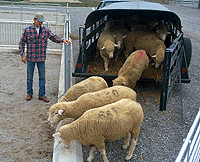Forage Based Research Emphasized at New UK Animal Research Center
Forage Based Research Emphasized at New UK Animal Research Center

Instead of a ribbon festooned champagne bottle, two truckloads of bleating sheep were used to christen the first major building that has been opened up out at the University of Kentucky's Animal Research Center in Woodford County.
It will still be a number of months before all the facilities that will house the beef, sheep and swine herds will be operational. The faculty and administration in the UK College of Agriculture view this as the beginning of an exciting future aimed at addressing some of the specific needs of Kentucky's agricultural industry.
The farm's research efforts will emphasize the fact that grass and legume crops already covering the rolling hills of this state have a lot more profit potential and that the right kinds of data will provide economic and environmentally sound ways of maximizing their use.
Kentucky has eight million acres of forage land," said C. Oran Little, dean of the UK College of Agriculture. We take forages and we end up selling that product in the form of beef. Not a whole lot of people are going to put fescue grass on the dinner table, but a whole lot of people like t- bone steaks," said Little.
And Little predicts a rosy future for animal agriculture. It is already a two billion dollar industry in the state with a real potential for a great deal more growth. It hasn't been realized to this point for several reasons.
"We have neglected to put the details into animal management," said Little. " I think this facility will help to answer some of the nagging little questions about what constitutes the best management practices for our ruminant livestock and that in turn will help us to then get maximum utilization of our available feed stuffs."
An even broader goal of the farm's research mission will be to study total nutrient management.
"We plan to recycle every bit of nutrient from the animal waste generated by this facility back on to the land," said Little. "As a result, our research farm design will give us the unique capability to answer the question of how can we feed our livestock, recycle their wastes and make the whole process environmentally sound."
"This farm provides us with an opportunity here that has never existed before," said Guy Kiracofe, chairman of the animal science department in the UK College of Agriculture. "As we put animals on the farm we can control the concentration of animals, we can look at water quality, and we can see what happens as there is nutrient build up on the land."
UK researchers have been gathering baseline data about the farm's soil and water since it was purchased in 1992.
"This farm is just fantastic for this kind of research," noted Kiracofe. "Eighty percent of it drains into one stream and we can monitor water quality much better than we could on any other farm."
Answers regarding the effects of varying amounts of animal nutrients on Kentucky's soil and in its water is needed quickly.
"We are about to come up against some major challenges in environmental issues," said Little. "It is pretty easy to sit back and predict that if the environmental restrictions continue we are not going to be able to afford to be in animal agriculture. The sad fact is that many of the regulatory decisions being passed down are based on partial data. This farm can play a critical role in generating a true picture of the problems and solutions." Little noted that when the beef, sheep and swine herds have been moved into their new facilities next year, that phase one of the farm's development will be nearly complete.
The UK College of Agriculture is asking the state legislature to consider additional appropriation money to bring the other livestock units to the farm that are currently located on the Coldstream farm complex located on the north edge of Lexington.
Funding is also being requested to build a education center that could be used by UK College of Agriculture students and the general public. The facility would be used to deliver the latest information generated by the farm's research efforts and to provide key management information to constantly improve the state's livestock industry.
"When complete, this farm's facilities and location should help bring a lot of identity to Kentucky's animal industry, said Little. "We will have one of the top animal research facilities in the world."
